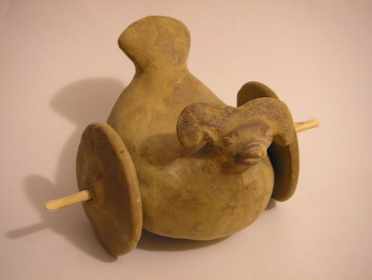Indus Valley Civilization and the Vedic Period

Origin, Golden Age and Collapse of the Indus Valley Civilization
Indus Valley Civilization was an ancient civilization in the Indus River valley in modern-day Pakistan and northwestern India which flourished from about 2500 to 1500 BC. Much of the Indus Valley Civilization remains a mystery including its origin, collapse and political organization. It also remains unknown whether the two most important cities – Harappa and Mohenjo-daro were two large cities of a single empire or capitals of two independent political units. Though the collapse of the Indus Valley Civilization is traditionally attributed to the Indo-Aryan invasion the archaeological evidence imply that both Harappa and Mohenjo-daro collapsed before the arrival of the Indo-Aryans.
Harappa and Mohenjo-daro
Most scholars believe that the Indus Valley Civilization developed from an agricultural society which depended on artificial irrigation. Archaeological finds in both Harappa and Mohenjo-daro reveal large hill citadels encompassing palaces, large granary and elaborate baths implying on an existence of centralized government. Both cities were well planned and had highly advanced drainage systems. Uncovered were also many art works and numerous steatite seals almost exclusively depicting animal motifs. Many steatite seals include a pictographic scrip which has not been fully deciphered yet. The language that was spoken in Indus Valley Civilization appears to be related to Dravidian languages.
Arrival of Indo-Aryans and their Origin
The northern Indian subcontinent was settled by the Indo-Aryans about 1400 BC. Much of Indo-Aryans including their origin and migration remains unknown. They are believed to have originated from the steppes north of the Caspian Sea and to migrate across the Iranian plateau to India. The main source for history of India between 1400 and 550 BC are the Vedas, sacred texts consisting of four collections known as Rigveda, Yajurveda, Samaveda and Atharvaveda. History of India from 1400 BC and 550 BC is therefore referred to as the Vedic period.
Emergence of the 16 Kingdoms (Mahajanapadas)
On the arrival to India, the Indo-Aryans were organized into tribes or clans called the vish ruled by the raja. The Indo-Aryan clans struggled with non-Aryan tribes called the Dasyu - most likely the indigenous inhabitants as well as with each other. The rivalry between the Indo-Aryan clans is also the central event in the great epic Mahabharata. Clans were eventually replaced by territorial identity and 16 kingdoms known as Mahajanapadas emerged in north India by the end of the Vedic period.
Caste System
The Vedic period saw the development of the specific caste system which was most likely a result of Indo-Aryan struggles with the Dasyu as well as with each other. The four varnas which came to be known as the four classes of Indian society are first mentioned in Rigveda, the oldest of all Vedas: Brahmans (priests), Kshatriyas (kings, nobility, warriors), Vaishyas (merchants) and Sudras (workers, peasants). On the bottom of social hierarchy were the Dalits or the untouchables who were outside the varna system. All four varnas were further subdivided into jatis, the actual castes.
Religion during Vedic Period
The Indo-Aryan religion eventually evolved into Brahmanism, the precursor of Hinduism. The main sources for religion during the Vedic period are the Vedas which are believed to be divinely revealed scriptures and other Vedic literature – Brahmanas, Upabishads and Aranyaka. In contrary to other ancient civilizations, no monumental temples nor religious buildings were built during the Vedic period in India.




